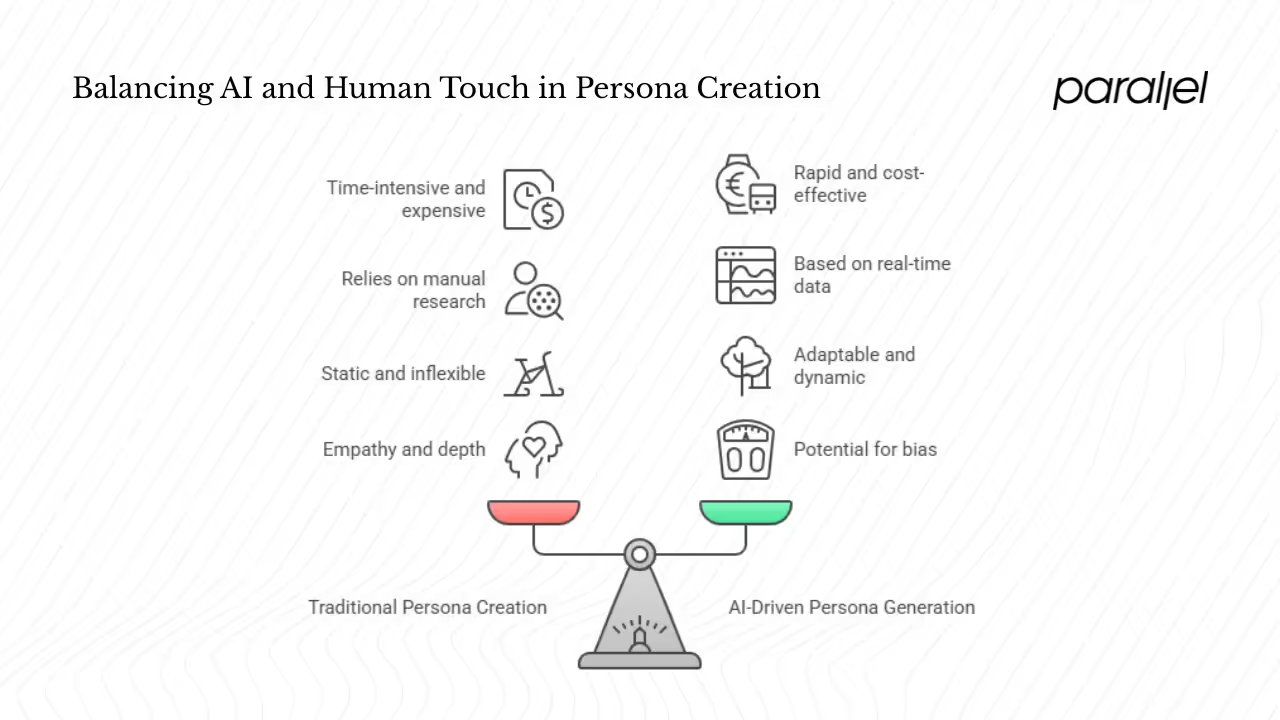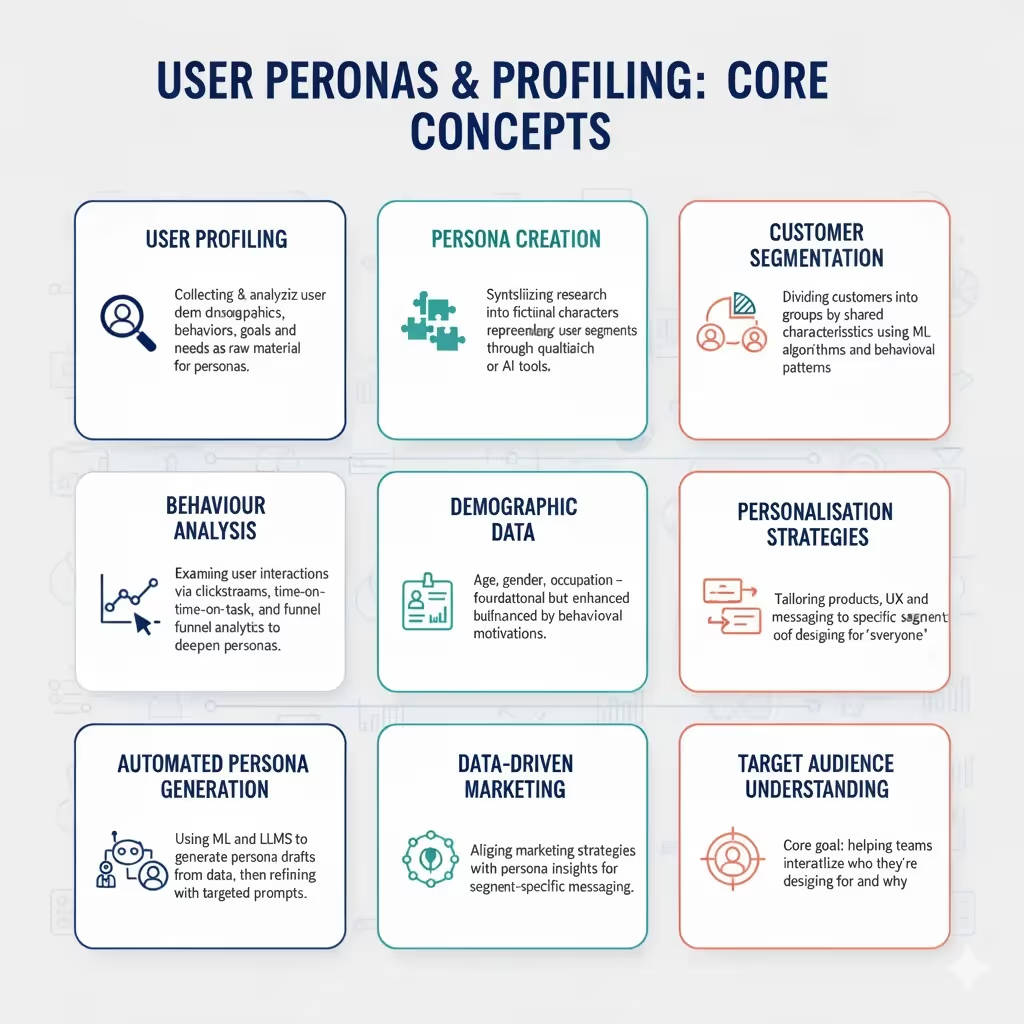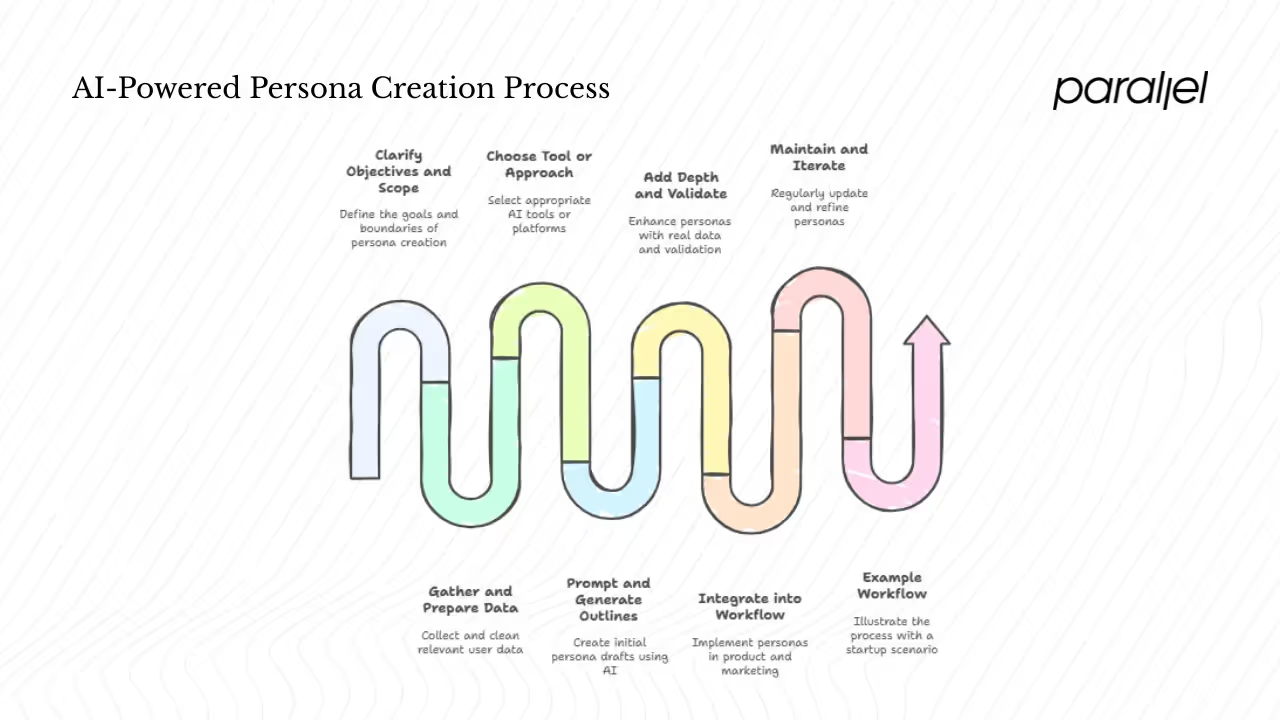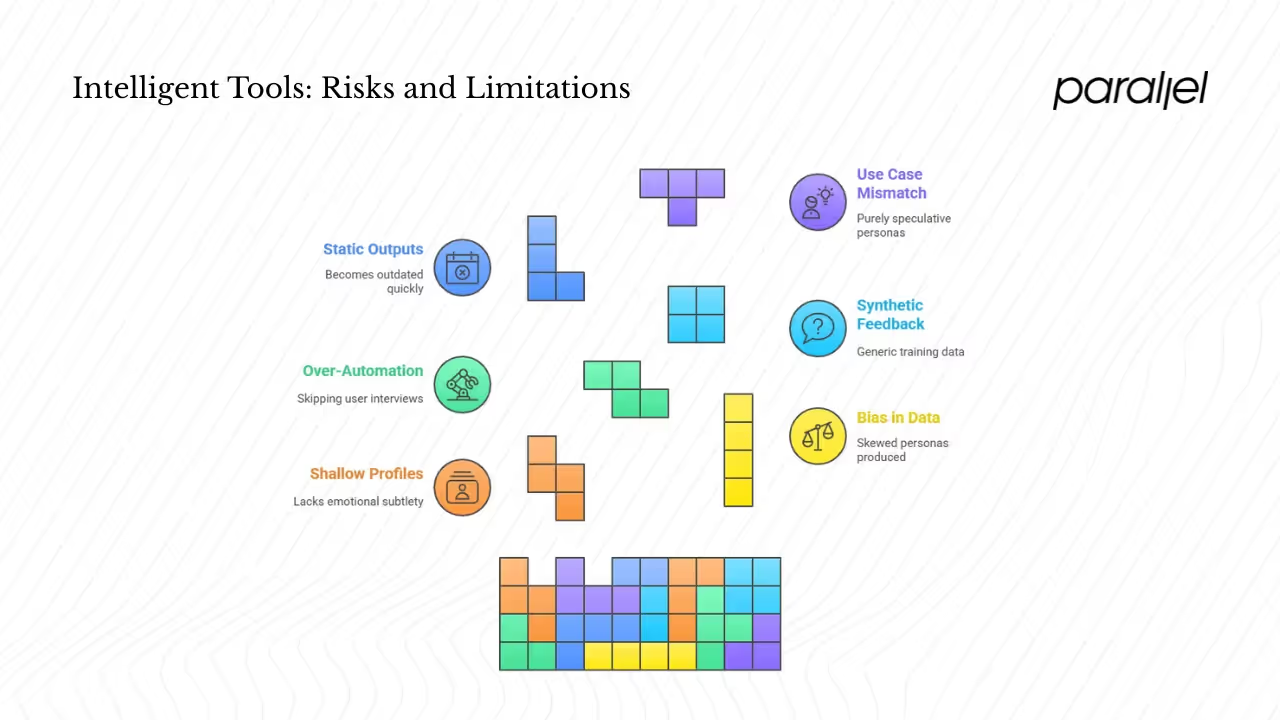Using AI for User Persona Generation: Guide (2026)
Discover how AI tools can generate data‑driven user personas, accelerating research and informing design decisions.

In small product teams, the ability to see the world through your users’ eyes is a secret weapon. A well‑crafted persona condenses interviews, observations and analytics into a vivid character that everyone on a project can relate to. The UX Design Institute defines a persona as a fictional character which represents traits of real users; a good persona is grounded in facts and data about real users. In an era when large language models and machine learning can summarise huge datasets in seconds, it’s natural to ask how far we can go in using AI for user persona generation. This article explains why modern teams are experimenting with intelligent systems, what benefits and pitfalls to expect, and how you can introduce these tools responsibly.
Why use intelligent systems for persona generation?
The pain points of traditional persona creation
Creating a strong persona has always required patience. Researchers recruit participants, carry out interviews and ethnographic observations, transcribe notes, group data with affinity diagrams and then synthesise it into characters. An industry paper on vector personas points out that the effectiveness of personas depends on reliable user data; poorly researched or assumption‑based personas often make problems worse. Marvin’s 2025 guide on machine‑learning personas lists practical obstacles: manual research is time‑intensive and expensive, relies on in‑person methods that miss web‑based behaviour, requires constant updates to stay relevant, and sometimes involves filling gaps with guesswork – decisions made on incorrect assumptions can harm the product.
Static personas also struggle to keep up with fast‑evolving products. Many teams freeze their personas once the design is underway, yet user preferences and behaviours shift. The Interaction‑Design Foundation warns that personas must be revisited and updated regularly because markets, products and technology change. Without a maintenance plan, a persona quickly becomes a caricature instead of a useful decision tool.

What intelligent systems bring to the table
Modern learning systems, including large language models and machine‑learning‑driven segmentation tools, can dramatically reduce the time needed to build a first‑cut persona. UXPin’s 2024 article explains that automated personas can be based on actual user behaviour and real‑time data rather than assumptions, making them more representative of current user needs. In practice this means mining analytics logs, surveys, support tickets and CRM data to discover patterns and segmentations that might be invisible with manual sorting. Instead of weeks of research, a first persona outline might emerge in minutes – a big advantage for lean teams.
Another benefit is adaptability. Automated personas can be refreshed as new data arrives. For example, the same UXPin article notes that automated profiles can be updated by feeding new behavioural or demographic data into the model, allowing personas to evolve with user trends. Machine‑learning‑driven clustering tools (such as those described in Marvin’s article) can group audiences based on demographics, purchase patterns and behavioural variables, constantly refining segments as fresh data flows in. This adaptability helps product teams keep their empathy maps current. Overall, these capabilities show why using AI for user persona generation is attracting interest among lean startups and product teams.
Watch outs: empathy, bias and trust
Automated persona tools are tempting because they feel objective, but over‑reliance is risky. Nielsen Norman Group’s 2024 article on synthetic users reminds researchers that real user research is essential – synthetic profiles cannot replace the depth and empathy gained from studying and speaking with real people. Synthetic characters may produce favourable responses that hide critical issues; they also miss the complexity of real human behaviour and provide flat approximations of thousands of people. Machine‑generated responses rely on training data that designers cannot control; the resulting answers may not match real user experiences.
Bias is another concern. A Medium essay on generative‑powered UX warns that machine‑generated personas are only as reliable as the data they’re trained on. Biases in training datasets can lead to skewed personas, and the inner workings of some models are opaque, making it difficult to understand how they arrived at certain outputs. The same author emphasises that user interviews and moderated testing remain irreplaceable because intelligent systems lack the ability to understand motivations and needs on a deeper level. In short, using AI for user persona generation should complement human‑led research, not replace it.
Core concepts and essential terms

User profiling: The practice of collecting and analysing data about users’ demographics, behaviours, goals and needs. Profiling is the raw material that feeds personas.
Persona creation: This refers to synthesising research into fictional characters that embody important segments. Traditional creation relies on qualitative research and affinity diagramming (as described by the Interaction‑Design Foundation). Automated or machine‑enhanced creation uses tools such as ChatGPT or research platforms to compile patterns from data, generating initial persona drafts quickly.
Customer segmentation: The process of dividing customers into groups based on similar characteristics. Machine‑learning algorithms can cluster users by behaviours, demographics or psychographics, enabling targeted personas.
Behaviour analysis: Examining how users interact with products (e.g., clickstream analytics, time‑on‑task, funnel drop‑offs) and using that information to deepen personas.
Demographic data: Includes age, gender, occupation and location. While still relevant, modern persona creation goes deeper into behaviours and motivations. The UX Design Institute emphasises that personas should be based on facts and data about real users, not just demographic details.
Personalisation strategies: Using personas to adapt products, interfaces and marketing messages to specific segments. Without a clear persona, teams often design for “everyone” and end up satisfying nobody.
Automated persona generation: Employing machine learning or large language models to produce persona drafts from data and prompts. UXPin’s guide shows how to use ChatGPT to generate names, goals and pain points, then refine them with specific prompts.
Data‑driven marketing: Aligning marketing strategies with insights from personas. Once personas are grounded in behavioural data, marketing teams can craft messages that speak directly to each segment’s needs.
Target audience understanding: The overarching goal of persona work. Whether created manually or with intelligent systems, personas help teams internalise who they’re designing for and why.
Implementing machine‑powered persona creation: step‑by‑step
This section offers a practical process for founders, product managers and design leaders to incorporate intelligent tools into their persona workflow. It draws on research from Interaction‑Design.org, UXPin and Marvin to balance automation with human insight.

Step 1: Clarify your objectives and scope
Before tapping into large language models, get specific about what you’re trying to achieve. Are you a fintech startup refining onboarding flows? A marketplace validating feature priorities? List the decisions that will rely on your personas (product features, UX flows, marketing messaging) and the data sources you have available. Decide how many personas you need and what level of detail is useful – too many profiles dilute focus. A clear objective keeps the process grounded and helps you prompt systems effectively.
A clear objective also ensures you ask the right questions when using AI for user persona generation.
Step 2: Gather and prepare your data
Good personas start with good inputs. Collect survey responses, interview transcripts, analytics logs, CRM records and market research. Marvin’s guide recommends combining quantitative data (e.g., analytics, purchase patterns) with qualitative insights (e.g., interviews). Clean the data to remove duplicates and irrelevant fields. Check for biases or gaps – if your dataset over‑represents a particular demographic, acknowledge this in your analysis. When using external segmentation or clustering tools, ensure compliance with privacy regulations and obtain consent where required.
High‑quality inputs are the foundation of accurate results when using AI for user persona generation.
Step 3: Choose an appropriate tool or approach
There are two main paths: general‑purpose large language models (ChatGPT, Claude, Gemini) or specialised research platforms. General models are flexible and accessible; you can feed them structured data and prompt them to draft personas. Dedicated platforms may integrate directly with your analytics and CRM systems, automating the pipeline from raw data to persona. Consider your budget, technical skills and the importance of integration when selecting a tool. Keep in mind that machine‑generated personas should supplement, not substitute, real research.
Step 4: Prompt and generate initial persona outlines
Begin with a clear prompt that includes demographic or behavioural context: for example, “Generate a persona for a 28‑year‑old mobile‑first user of our SaaS platform who frequently uses analytics dashboards and struggles with onboarding.” UXPin’s guide shows that you can ask for specific fields – name, age, occupation, goals, pain points, behavioural traits and technology preferences. After receiving an initial outline, ask follow‑up questions to deepen the persona: What motivates them? What does a typical day look like? What quotes might they say? This interactive process helps you refine the character and avoid bland stereotypes.
Step 5: Add depth and validate with real data
Once you have a draft, layer in behavioural and analytics data. For instance, cross‑check the persona’s pain points against actual user‑journey metrics – are users abandoning during onboarding? Are there support tickets confirming the pain? Label any assumptions versus facts so that stakeholders know which parts need further research. UX Collective’s essay on generative UX notes that large models lack the ability to understand user motivations and needs on a deeper level, so human interviews and moderated testing remain vital. Use the persona as a hypothesis and test it against reality.
Step 6: Integrate personas into your workflow
Personas are valuable only when teams actually use them. Share your personas across product, design and marketing – pin them on digital boards, include them in briefing documents, and refer to them in prioritisation sessions. Ask questions like “Would this feature help [Persona Name] achieve their goal?” when discussing trade‑offs. Tie each persona to specific onboarding flows, feature sets and messaging strategies. For example, a fintech startup might design a simplified dashboard for a “Busy Founder” persona and a more detailed analytics view for a “Growth Hacker” persona.
Step 7: Maintain and iterate
Machine‑powered personas are not “set and forget.” Schedule regular reviews – monthly or quarterly – to incorporate new data and adjust descriptions. The Interaction‑Design Foundation emphasises that personas must change as user needs and behaviours evolve. Use analytics to detect shifts in user behaviour, run periodic surveys, and update your models accordingly. Document the date and version of each persona so your team knows which profile is current.
Step 8 (optional): Example workflow for an early‑stage startup
Imagine a fintech startup with a handful of MVP users. The team collects behaviour data from product analytics (e.g., time to complete onboarding, features accessed) and feedback from support tickets. They feed this data into a large language model, prompting it to generate two personas: “Asha,” a small business owner overwhelmed by financial jargon, and “Ravi,” a tech‑savvy freelancer seeking automated insights. The team then validates these personas by interviewing five real customers and comparing the results. They refine Asha’s pain points (clarity of cash‑flow forecasting) and Ravi’s goals (quick integration with accounting tools). During the next sprint, designers prioritise an onboarding tutorial customised for Asha and a flexible dashboard for Ravi. They continue to refine the personas every few weeks as more customers sign up. This workflow demonstrates using AI for user persona generation as a partner to human insight.
Best practices and tips for startups
- Start learning. Focus on one or two primary personas that capture the most critical user segments. The Interaction‑Design Foundation advises that too many personas dilute focus.
- Combine qualitative and quantitative data. Use interviews and observations to understand motivations and behaviours, then validate trends through analytics and surveys.
- Get stakeholders involved. Invite engineers, marketers and support staff to participate in research sessions and persona reviews. Shared ownership increases adoption.
- Avoid assumption‑driven personas. The vector personas paper warns that poorly researched personas can exacerbate issues. Always label hypotheses and revisit them as new information comes in.
- Use personas to drive real decisions. Link personas to feature prioritisation, onboarding flows and messaging strategies. Set measurable goals (e.g., increase onboarding completion rate for “Asha” by 10%).
- Respect ethics and privacy. When segmenting users by demographics or behaviours, ensure that data collection complies with privacy laws. Do not include identifiable user details in personas.
- Measure impact. Track whether persona‑driven changes improve metrics (e.g., conversion rates, feature adoption). If not, revisit your personas.
Following these practices will help you make the most of using AI for user persona generation without losing sight of your users.
Use cases and real‑world examples
- UXPin’s persona and experience map creation: The 2024 UXPin article demonstrates how a designer can prompt ChatGPT to build a persona, then expand it with scenarios and a user path. The article’s sample outputs include realistic goals and frustrations, showing how automated assistance accelerates ideation.
- Vector personas study: Researchers at UXPA Journal compared personas built from real interviews with those created by ChatGPT. They then blended insights from both into a “vector persona” that balanced speed and depth. Their conclusion: automated outputs can enhance efficiency but do not replace the depth of human research. The study underlines the value of hybrid approaches.
- Synthetic users concept: Nielsen Norman Group evaluated “synthetic users” – machine‑generated participants for usability testing. They observed that synthetic users often give overly optimistic responses and miss contextual nuances; real user research remains essential. The article’s cautionary stance helps teams avoid over‑trusting machine‑generated feedback.
- Early‑stage startup scenario: A SaaS startup used machine‑generated personas to identify a hidden segment of power users who frequently exported data but complained about API limits. By creating a persona for this segment, the team prioritised API improvements that led to a 20% decrease in support tickets. This example shows how using AI for user persona generation can surface patterns that manual research might miss.
Risks, limitations and when not to rely solely on intelligent tools

- Shallow profiles: Machine‑generated personas may lack emotional subtlety, empathy and real‑life context. NNG notes that synthetic users feel like flat approximations. Without human insight, they risk steering design decisions in the wrong direction.
- Bias in data: Models trained on biased or incomplete data will produce skewed personas. The UX Survival Guide article warns that machine‑powered tools are only as reliable as the data they’re given, and designers must actively mitigate bias.
- Over‑automation: Lean teams may be tempted to skip interviews altogether. This is dangerous: user research provides motivations and context that numbers and generated text cannot capture.
- Validity of synthetic feedback: Synthetic users may respond based on generic training data rather than actual product experience. NNG’s study highlighted that synthetic responses are based on training data you can’t control, making them untrustworthy for final decisions.
- Static outputs without maintenance: Even if a persona is machine‑generated, it becomes outdated if not refreshed. Review and update your personas as your product and market evolve.
- Use case mismatch: If you have zero user data, machine‑generated personas may be purely speculative. They can inspire ideation but should be marked as low‑confidence and validated as soon as real data is available.
Conclusion
Personas are still one of the most effective tools for aligning teams around real user needs. Intelligent systems and large language models provide new opportunities to speed up persona creation, uncover hidden segments and keep profiles current. At the same time, real user research, empathy and human judgement remain irreplaceable. As we’ve seen, static, assumption‑driven personas can cause harm, and synthetic users lack the nuance of real human behaviour.
A balanced approach combines the best of both worlds: use machine‑generated personas for rapid hypothesis generation, then ground them in observation and ongoing data collection. For early‑stage founders and product leaders, using AI for user persona generation is a powerful addition to the toolbox – one that, when used wisely, can help you build products that truly meet the needs of the people you serve.
FAQ
Q1. Which intelligent tool is most effective for generating customer personas?
There is no one‑size‑fits‑all tools. General models such as ChatGPT and other large language models are flexible and can generate persona drafts from prompts, while dedicated platforms (e.g., research repositories with machine‑learning clustering) integrate with analytics and CRM data. Choose based on your data environment, integration needs, team workflows and budget. Regardless of the tool, remember that automated personas should complement, not replace, real user research.
Q2. What are machine‑generated personas?
These are user profiles created or enriched using learning systems. UXPin defines them as simulated user profiles generated or enhanced by analysing large sets of user data, behaviours and preferences. They typically include demographic sketches, goals, pain points and behaviours. They are most effective when used alongside traditional research and updated regularly.
Q3. How do I create personas using ChatGPT?
First, gather data from surveys, analytics and user feedback. Then craft a prompt specifying your target segment (e.g., “Generate a persona for small business owners in India aged 30–45 who use mobile invoicing apps and struggle with onboarding”). Ask the model to provide fields such as name, age, occupation, goals, frustrations and technology preferences. Refine the persona by asking follow‑up questions to expand motivations, behaviours and quotes. Finally, validate the persona against real user data and adjust as needed.
Q4. Does persona creation have to use intelligent systems?
No. Traditional persona creation still starts with user research, interviews and behavioural analysis. Intelligent tools can accelerate the process and reveal patterns in large datasets, but they are optional. Use them when you need speed and have sufficient data. In cases where you have little or no user data, manually crafted personas based on exploratory research may be more appropriate until you can gather meaningful data.








.avif)




